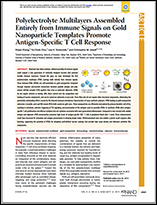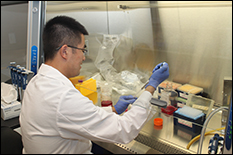Fischell Researchers Develop Innovative Technique to Fine-Tune Vaccines
For more than a century, biomedical researchers and physicians have looked to vaccines to treat myriad diseases, from smallpox and the flu, to HIV and cancers. But, recent findings published in ACS Nano by the Fischell Department of Bioengineering (BioE) Jewell Research Lab could help transform how bioengineers both design and measure the efficacy of vaccines and their individual components. Even more, the lab’s findings offer promise that bioengineers could soon custom-design vaccines to better control immune responses to cancer treatments and infectious diseases. Vaccines work by exposing the body to antigens, molecules that can trigger a specific immune response. The antigens carried by vaccines mimic, or are fragments of, pathogens – a bacterium, virus or other microorganism that causes disease. Additionally, vaccines carry stimulatory signals – adjuvants –that help the immune system generate large responses against antigens. With both components, vaccines can mimic a specific pathogen in order to stimulate the body’s immune system to build up defenses against disease agents. In recent years, bioengineers have intensely studied the use of biomaterials as vaccine carriers, as they offer advantages such as controlled release of the vaccine, targeting and “cargo” protection; however, biomaterials-based vaccines present a number of challenges, too. To start, biomaterials carriers often contain components that can activate the immune system by themselves in ways unintended. This means that, even if a one knows what to expect from a certain vaccine, he or she may find that the biomaterials used as carriers alter the immune response triggered by the vaccine. As a result, vaccines that offer promising treatment or cures for diseases might not have the same effects as predicted because the carrier itself alters the response to the antigens. Further, this challenge – one shared by all vaccines – makes understanding how existing and new vaccines work difficult because the role of each individual component to the vaccine’s overall effectiveness is unclear.
Together, BioE Postdoctoral Associate Dr. Peipei Zhang, National Institutes of Health Postdoctoral Fellow Dr. Yu-Chieh Chiu, BioE Ph.D. student and National Science Foundation Graduate Student Fellow Lisa Tostanoski, and BioE Assistant Professor Christopher Jewell have developed the first polyelectrolyte multilayer (PEM) vaccine coatings built entirely from immune signals. These immune-PEMs are self-assembled on gold nanoparticle (AuNP) templates, which are both immunologically inert and nontoxic. In this way, the team has constructed a vaccine design that would allow bioengineers to achieve many of the same benefits biomaterials-based vaccines provide without the intrinsic features of biomaterials that can complicate vaccine design and evaluation. “Vaccines have really been transformative for public health because they can stop or even eradicate disease with a single does,” Jewell said. “One of the surprising aspects to these technologies, however, is that we really don’t have a good idea how to design a vaccine from the ground up. Rather, vaccines are usually screened empirically to find formulations that work. We’re hoping to create technologies that simplify vaccine design and allow us and others to make this process more efficient.” The Jewell Lab’s findings are not only promising for the future of vaccine design, they are also indicative of the fact that the field of bioengineering at large has covered a great deal of ground in just a few years’ time. Less than a decade ago, for instance, bioengineers believed that the polymers frequently used in vaccines were inert, Jewell said. “New discoveries, however, have helped us understand the types of questions bioengineers need to ask about vaccine design, and the ways various elements of a vaccine impact results,” he said. “Moving forward, this research will help in the design of vaccines that offer more control over the specific kinds of responses that are generated.” While the Jewell Lab continues to apply their findings using model antigens, their next step is to apply their design to improve the efficacy and targeting of cancer vaccines, Jewell said. The research team’s ACS Nano paper, “Polyelectrolyte Multilayers Assembled Entirely from Immune Signals on Gold Nanoparticle Templates Promote Antigen-Specific T Cell Response,” is available online.
Related Articles: June 26, 2015 Prev Next |



 Recognizing these challenges, the Jewell Research Lab is working to simplify vaccines by assembling immune signals in ways that eliminate traditional biomaterials but that maintain some of the useful features such as co-delivery of vaccine signals.
Recognizing these challenges, the Jewell Research Lab is working to simplify vaccines by assembling immune signals in ways that eliminate traditional biomaterials but that maintain some of the useful features such as co-delivery of vaccine signals.